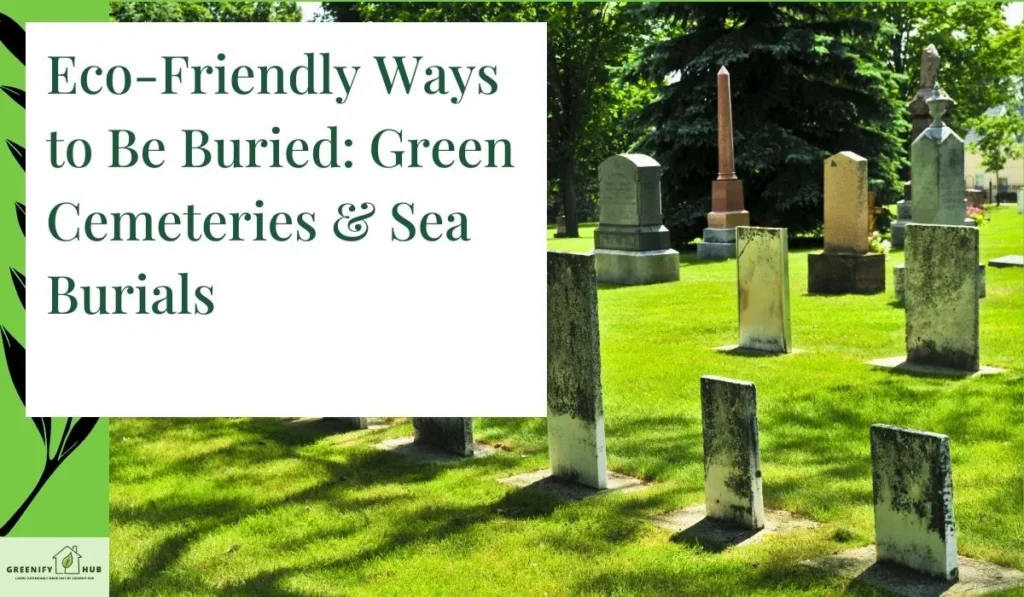Eco Friendly Ways to Be Buried: Green Cemeteries & Sea Burials

Looking to leave a green legacy? Ever wondered about eco friendly ways to be buried? It’s time to explore sustainable options that honor the Earth even in the afterlife. Discover how you can make a positive impact on the environment with burial practices that are both meaningful and environmentally conscious. Ready to learn more about eco-friendly end-of-life choices that align with your values? Let’s delve into innovative ways to rest in peace while preserving our planet for future generations.
Key Takeaways
- Consider eco-friendly burial options: Explore green burial methods like aquamation, mushroom suits, sea burial, and recomposition for a more environmentally conscious end-of-life choice.
- Research green cemeteries: Look for green cemeteries that support eco-friendly practices and offer natural burial grounds.
- Evaluate the costs: Understand the financial aspects of eco-friendly burial options compared to traditional methods to make an informed decision.
- Make a sustainable choice: Opting for eco-friendly burial methods can reduce the environmental impact of traditional burial practices, contributing to a greener future.
- Connect with nature: Embrace the idea of returning to the earth in a natural and sustainable way by choosing eco-friendly burial alternatives.
- Personalize your end-of-life plans: Consider how eco-friendly burial options align with your values and beliefs, creating a meaningful and environmentally friendly legacy.
Understanding Green Burial
Green Practices
Green burials are environmentally friendly ways of laying the deceased to rest. These burials focus on sustainability and conservation, minimizing the ecological impact compared to traditional methods.
Process Details
During a green burial, the body is not embalmed using harsh chemicals, allowing it to naturally decompose. Biodegradable caskets made from materials like bamboo or wicker are used instead of non-biodegradable options.
Conservation Importance
Green burial grounds serve as natural sanctuaries that promote biodiversity and protect wildlife habitats. These areas are maintained in a way that supports local ecosystems and reduces carbon emissions.
Exploring Aquamation
Water-Based Process
Aquamation, also known as alkaline hydrolysis, is a water-based process that offers an eco-friendly alternative to traditional cremation. In aquamation, the body is placed in a fluid solution of water and potassium hydroxide, which is then heated and pressurized. This process accelerates the natural decomposition of the body, leaving behind only the bones.
Energy Efficiency
Compared to cremation by fire, aquamation uses significantly less energy and produces fewer greenhouse gas emissions. The fluid used in aquamation is heated to around 160-180 degrees Fahrenheit, much lower than the temperature required for traditional cremation. This lower heat requirement contributes to its energy efficiency and reduced environmental impact.
Legalization and Adoption
Aquamation is currently legalized in several states across the United States, including California, Colorado, Florida, and Minnesota. As awareness of eco-friendly burial options grows, more states are considering legalizing aquamation. Notable figures such as environmental activists and sustainability advocates have chosen aquamation as their preferred method of disposition, citing its environmental benefits and minimal ecological footprint.
Discovering Mushroom Suits
Mushroom Suits
Mushroom suits are innovative eco-friendly alternatives for traditional burials. These suits are embedded with mushroom spores, which play a crucial role in decomposing human tissue. As the body decomposes, the mushrooms consume the dead tissue, aiding in the natural recycling process.
The unique feature of mushroom suits lies in their ability to break down human remains efficiently. The mushrooms within the suit are specifically trained to target and consume dead human tissue, accelerating the decomposition process. This natural decomposition not only benefits the environment but also eliminates the need for embalming chemicals, promoting a more sustainable burial practice.
Toxin Purification
One significant advantage of mushroom suits is their capability to absorb and purify toxins from human remains. As the mushrooms grow and feed on the body, they also absorb any harmful substances present in the remains. This process not only aids in toxin purification but also prevents these substances from seeping into the surrounding soil, thus minimizing environmental impact.
Pros:
- Environmentally friendly alternative to traditional burials
- Natural decomposition process without harmful chemicals
- Toxin absorption and purification benefits for the environment
Cons:
- Limited availability and awareness compared to conventional burial methods
- Cultural or religious considerations may affect acceptance
- Requires specific conditions for optimal decomposition
Environmental Impact
The use of mushroom suits contributes significantly to reducing the environmental footprint of burials. By opting for a mushroom burial suit, individuals can actively participate in sustainable end-of-life practices. The decomposition process facilitated by mushrooms not only enriches the soil but also helps in restoring ecological balance by purifying toxins and preventing them from entering the ecosystem.
Considering Sea Burial
Water-Soluble Urns
Water-soluble urns are a popular choice for sea burials, designed to float briefly before gracefully sinking. These urns break down naturally in water, allowing the ashes to disperse gradually.
Eco-friendly concrete is another innovative option for sea burials. This material is sustainable and doesn’t harm marine life, offering a natural burial alternative that aligns with environmental values.
Historical Significance
Sea burials have a rich history dating back centuries. Sailors and ocean lovers often opt for this method, believing it connects them spiritually to the vast ocean they cherished during their lives.
- Connects spiritually to the ocean.
- Breaks down naturally in water.
Sea burials provide a serene final resting place, where loved ones can find solace in knowing their departed have returned to the embracing arms of the sea. The practice symbolizes a harmonious cycle of life and nature, emphasizing the interconnectedness of all living beings with the environment.
Learning About Recomposition
Natural Transformation
Recomposition, also known as body composting, is an innovative process where human bodies are converted into soil naturally. Through this method, the deceased’s remains are placed in a vessel with organic materials like wood chips, alfalfa, and straw. Over several weeks, microbes break down the body, turning it into nutrient-rich soil.
Environmental Benefits
One of the significant advantages of recomposition is its environmental sustainability. Unlike traditional burials that involve embalming fluids and concrete vaults, recomposition is a greener option. It reduces carbon emissions and prevents harmful chemicals from seeping into the soil.
Legal Considerations
When opting for recomposition, it’s essential to consider the legal aspects. Laws surrounding this practice vary by state, so consulting a law attorney familiar with green burials is advisable. Understanding the regulations can help ensure a smooth process for families wanting to choose recomposition for their loved ones.
Comparing Eco-Friendly Options
Aquamation
Aquamation, also known as alkaline hydrolysis, involves dissolving the body in a water-based solution. This process uses less energy and emits fewer greenhouse gases than traditional cremation methods. The remains are returned to the family in a liquid form, which can be safely disposed of or used for planting trees.
Mushroom Suits
Mushroom suits consist of biodegradable materials infused with mushroom spores. When buried, the mushrooms help decompose the body naturally. These suits promote soil health by enriching it with nutrients and aiding in plant growth. They offer a sustainable alternative to traditional burial practices.
Green Burial
Green burials focus on returning the body to the earth with minimal environmental impact. They avoid embalming fluids and non-biodegradable materials. Bodies are buried in biodegradable caskets or shrouds, allowing for natural decomposition. This option helps conserve natural resources and reduce carbon emissions.
Sea Burial
Sea burials involve placing the body in a biodegradable container and submerging it in the ocean. This method provides a peaceful final resting place while supporting marine life. It minimizes land use and offers a serene alternative for those connected to the sea.
Recomposition
Recomposition, or natural organic reduction, transforms human remains into soil through microbial activity. It accelerates decomposition, creating nutrient-rich soil that can be used for planting. This innovative process reduces carbon emissions and promotes sustainability.
Pros:
- Environmentally friendly
- Supports natural processes
- Reduces resource consumption
Cons:
- Limited availability
- May not align with cultural beliefs
Personal Preferences and Values
When choosing among eco-friendly burial options, consider personal preferences and values. Each option offers unique benefits and considerations based on individual beliefs and environmental priorities. By selecting an eco-friendly burial method that resonates with personal values, individuals can leave a positive impact on the environment even after their passing.
Finding Green Cemeteries
Green Practices
Green cemeteries, also known as natural burial grounds, prioritize environmental sustainability. These sites avoid embalming fluids and non-biodegradable materials like concrete vaults. Hand-dug graves replace machinery, reducing carbon emissions and preserving the natural landscape.
Characteristics of Green Cemeteries
In green cemeteries, biodegradable caskets made from materials like wicker or cardboard are used. This ensures a more natural decomposition process compared to traditional coffins. Planting trees instead of headstones contributes to reforestation efforts and provides habitats for wildlife.
Conservation Efforts
Green cemeteries play a crucial role in wildlife and plant conservation. By creating natural habitats through tree planting and native vegetation restoration, these cemeteries support local ecosystems. Families find solace in knowing that their loved ones contribute to environmental preservation even after death.
Evaluating Costs
Aquamation
Aquamation, also known as water cremation, is gaining popularity as an environmentally friendly alternative to traditional burial methods. The process involves using water instead of flames to break down the body. This method offers a cost-effective solution for those looking to minimize their impact on the environment.
Mushroom Suits
Mushroom suits, made from biodegradable materials infused with mushroom spores, are a unique eco-friendly burial option. These suits help decompose the body naturally and enrich the soil with nutrients. While initially more expensive than traditional burials, the long-term benefits for the environment make them a sustainable choice.
Green Burial
Green burials involve burying the deceased in a biodegradable coffin or shroud without embalming fluids. This method allows for natural decomposition and reduces the use of resources. While costs may vary depending on location and specific services, green burials are generally more affordable than traditional funerals.
Sea Burial
Sea burials offer a serene and eco-friendly way to lay loved ones to rest in the ocean. The cost of a sea burial can vary based on factors such as location, type of service, and any additional requests. While it may be more expensive than some land-based options, sea burials provide a unique and environmentally conscious alternative.
Recomposition
Recomposition, also known as human composting, transforms human remains into soil through a natural decomposition process. This innovative method offers a sustainable way to return nutrients to the earth. While recomposition may have initial costs comparable to traditional burials, the long-term benefits for the environment are significant.
Aquamation:
- Cost-effective solution
- Uses water for body breakdown
Mushroom Suits:
- Biodegradable materials with mushroom spores
- Enriches soil with nutrients
Green Burial:
- Natural decomposition without embalming fluids
- Reduces resource usage
Sea Burial:
- Serene ocean burial option
- Cost varies based on location and services
Why Choose Eco-Friendly Burial
Environmental Impact
Traditional burial and cremation methods can have significant environmental consequences. Conventional burial practices involve embalming fluids that can seep into the ground, impacting soil and groundwater quality. The materials used in traditional coffins, such as metal and concrete, do not decompose easily, leading to long-term environmental harm.
Opting for sustainable burial options like biodegradable coffins or caskets can mitigate these negative effects. These eco-friendly containers are designed to break down naturally over time, minimizing the ecological footprint associated with burial practices. By choosing biodegradable burial containers, individuals can contribute to conservation efforts and reduce their impact on the environment.
Personal Values and Legacy Preservation
Selecting an eco-friendly burial method aligns with personal values of environmental consciousness and sustainability. It allows individuals to make a positive impact even after they have passed away. By opting for an eco-burial, people can ensure that their final resting place reflects their commitment to preserving the environment for future generations.
Moreover, eco-friendly burials offer a unique way to preserve one’s legacy. Instead of leaving behind a carbon footprint through traditional funeral practices, individuals can leave a lasting impression by choosing sustainable death care alternatives. This choice not only honors personal values but also serves as a tangible representation of one’s dedication to environmental stewardship.
Considerations for Sustainable Death Care
When evaluating end-of-life choices, it is essential to consider the long-term implications of traditional burial practices. Beyond the immediate costs associated with conventional funerals, there lies a broader responsibility to protect the planet for future inhabitants. Sustainable death care options provide a meaningful way to address this responsibility and promote environmentally friendly practices within the funeral industry.
Closing Thoughts
By now, you’ve delved into various eco-friendly burial options, from green cemeteries to aquamation and mushroom suits. Making a choice that aligns with your values not only benefits the environment but also leaves a meaningful legacy. Consider the costs, location availability, and personal preferences when deciding on an eco-friendly burial method. Your decision can contribute to sustainability efforts and pave the way for more environmentally conscious practices in the future.
Take the time to explore these choices further, discuss them with your loved ones, and make an informed decision that resonates with you. Your commitment to eco friendly burial practices can have a lasting impact and inspire others to follow suit. Embrace this opportunity to make a difference in how we approach end-of-life rituals.





